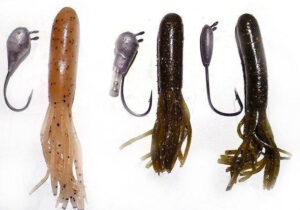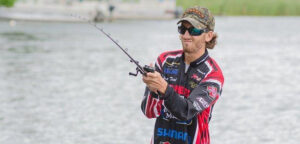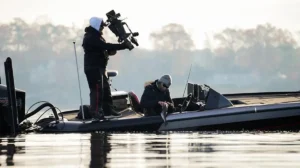Article written by Mark Hanowski
Fall is a great time to catch big bass. In the Midwest, this holds especially true for big smallmouth bass. These elusive brown fish, notorious for their “here-today, gone-tomorrow” behavior, come out to play when the leaves start their transformation into vibrant hues of yellow, orange and red.
Due to their innate tendency to feed often this time of year, anglers catch them with frequency in the fall. Catching these hungry, autumn smallmouth can be a cakewalk if anglers pay attention to a few small hints.
Minnesota touring pro Aaron Teal is an expert on North Country smallmouth. Teal amassed an impressive fishing resume at only 21 years of age with numerous wins and top-5 finishes in Minnesota bass circuits. Teal attributes much of his success to smallmouth.
He targets brownies year-round, but particularly loves fishing the fall period due to the possibility of catching true giants.
“From mid-September through October, finding smallmouth can be difficult,” Teal said. “The key to locating and catching these fish is finding the forage smallmouth prefer on any given fishery. I fish many natural, Minnesota lakes where the fish feed heavily on crawfish. When the smallmouth won’t eat the classic fall presentations like spinnerbaits, jerkbaits and swimbaits, I have found great success with crawfish imitating baits.”
Find simple crawfish imitators
Teal’s keeps it simple with two crawfish imitators in the fall:
- Football jig
- Tube
Teal employs a smaller profile football jig for smallmouth, especially in dirty or stained water. He prefers to use an exposed hook without a weed guard for an increase in hookup ratio. He chooses a 1/2-ounce All-Terrain Tackle Rock Jig. The Rock Jig has ridges on the head that easily transmit bottom composition, which informs Teal he’s in the right area.
He fishes the jig with simple sweeping or dragging motion focusing on keeping the bait in contact with the bottom. When the fish are feeding heavily, stroking the same football jig is often more effective.
As far as trailers go, Teal prefers a Chompers Twin Tail Skirted Grub. The double tail provides a perfect crawfish imitation in both appearance and action.
He likes a medium-heavy 7-foot, 5-inch G.Loomis GLX rod with 17-pound line for this approach.
In clear water, tubes work wonders for Teal. The tube has a slightly more subtle action than the football jig. He uses a 3/8- to 1/2-ounce goby-style jighead and inserts it into a Scheel’s brand tube.
He works this setup the same as the football jig with anywhere from 1- to 3-foot sweeps of the rod. The large head gets the bait to the bottom fast and keeps it there even in heavy wind or deeper water. The added weight gives him the advantage of covering water quickly. He can also cast it farther. In clear water it is essential that you make as long a cast as possible with a general rule that if you can’t see the smallmouth, the smallmouth can’t see you.
Match the hatch
If the smallmouth are not pursuing standard, moving baits this means they are relating to bottom structure and feeding on crawfish. Knowing this, anglers can adapt their presentations and baits to mimic these fleeing and defensive crawfish.
“When a smallmouth is caught, I always look down its throat to check for the presence of a recent crawfish meal,” Teal said. “If any forage is found, I examine the specimen. I look at color and size primarily. This will educate me on the general size and color of bait to use. “
Teal’s general rule of thumb in fall is browns and greens. Peanut butter and jelly, green pumpkin, and straight brown produce regularly for him on natural lakes.
Choose productive locations
In order to catch fish, an angler must first be able to find them. The whereabouts of smallmouth, especially in the fall period, can be difficult to pin down. Due to moving forage bases, smallmouth follow wherever the bait takes them. However, there are a few nuances Teal looks for in fisheries that reveal where the brownies might be hiding.
“On mid-fall lakes, I really like to target flats and anywhere sand, rock, or wood meet some type of an edge,” Teal said. “A combination of these three would be ideal. Depending on the body of water, smallmouth will position on the tops of flats in 3-6 feet of water, on edges of transition areas like where sand changes to rock or rock to gravel or on ledges.”
Be thorough but efficient
Just because many lakes have these flats and transition areas, doesn’t mean an angler automatically knows where to start.
“Fish as many of them as possible in a day,” Teal said.
The more spots you hit, the better your chances at smallmouth. The idea is to fish all of them efficiently while being extremely thorough at the same time. This may seem counterintuitive to many anglers, however, it is just a style of fishing that takes a little time to master. Efficient is fishing as slow and thorough as possible while still covering water.
After you get a few bites, make mental notes on the cover, structure and depth. Develop a pattern based on common characteristics in each area and start covering water with that pattern. Although you are covering water, continue fishing methodically and thoroughly.
In between your favorite football games this fall, get out on the water and chase some brown fish. Although these generally elusive fish won’t let you have your way with them every time out, the application of the information above will ensure that you find success on a more regular basis. If you heed Teal’s advice and put in several hours on the water, the smallmouth will greet you with open mouths.














